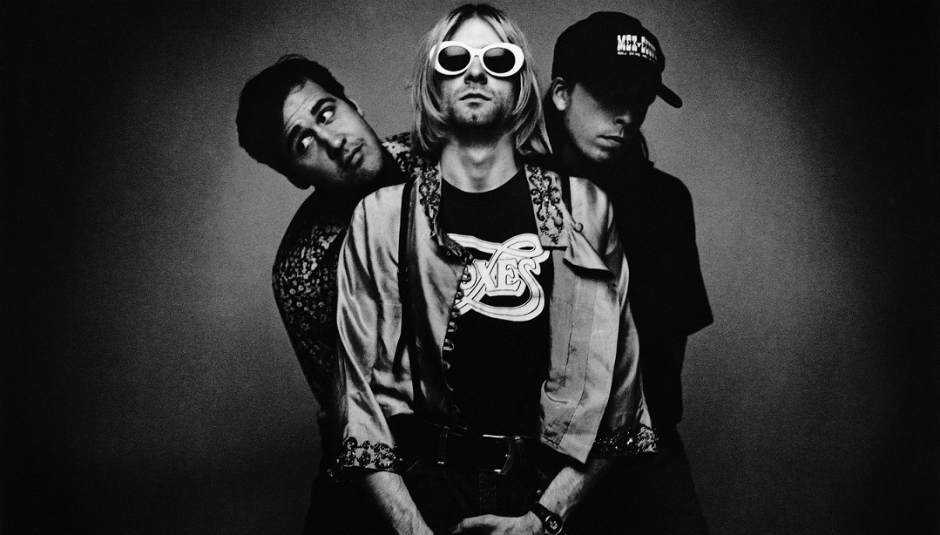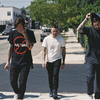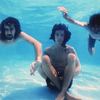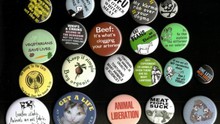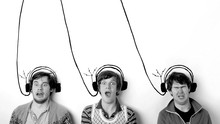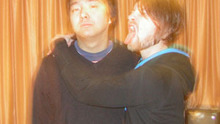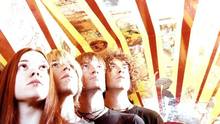An oft-repeated exercise for easy clickbait is to debate which year was the best ever for music. "1966!" claim the popsters for whom everything starts and ends with The Beatles. "1971!" retort those who like their tunes to have a heavier, seedier edge. And those of a younger generation might well point to 1991, the year when the depressing, deeply uncool cloak of the eighties was finally cast off, and a bright new dawn began. Sitting atop their argument is the colossus that is Nevermind, an album that came to define an entire era and generation by a band who adorned a million teenage bedroom walls.
That record, however, wasn't the be all and end all at the start of the nineties. In fact, you could argue that not only was it not the best grunge album - hello Mudhoney! - or the best that year, it wasn't even the best that came out that month, preceded as it was by towering releases by both Primal Scream and Guns N' Roses.
But we're all about inclusion here at DiS, so rather than a reductive ranking, we asked our writers to come up with 25 other albums from 1991 that have stood the test of time, presented below for your enjoyment. Taken together, they prove that 1991 wasn't just a vintage year for grunge, or rock, or any one particular genre; it was just a vintage year full stop.
The KLF - The White Room
You could argue that The KLF’s attempt to subvert the music industry failed due to the very fact that they succeeded. Much like Nevermind, critical acclaim was an afterthought for British anarchists Bill Drummond and Jimmy Cauty. Not knowing if their radical message had been received, the act responded by burning their profits, disbanding and then removing record from circulation – furthering its cult status. The White Room was originally intended as a movie - one that became fraught with massive budget and production faults. What was left was an album that incidentally set a new precedent for rave music, built around the duo’s sampling dexterity. ‘3 a.m. Eternal’ and ‘Last Train To Trancentral’ are timeless rave classics from a point when electronic music was seen as a renegade movement, while other moments such as ‘The White Room’ set new benchmarks for acid-house. In a time where music was dominated by the likes of U2, The White Room was never meant to be taken seriously, and because of this, it became a symbol of creative freedom, expression, and brilliance. They were indeed, and forever will be, the Justified and the Ancient.
Dan Cole
Bikini Kill - Revolution Girl Style Now
Though there had, of course, been feminist bands before Bikini Kill, the way they centred feminism as a radical and revolutionary practice was unprecedented. And the theoretical tone of many of ‘Feels Blind’’s lyrics feel just as punk as the angry, pained tone of the rest of Revolution Girl Style Now. But more than that, it doesn’t feel separate; they feel like the same thing. Kathleen Hanna had a talent for capturing the inextricability of the personal and the political in a hook as catchy as direct.
And therein lies possibly the most revolutionary thing about Bikini Kill. They may have come from an academic tradition of women’s studies, but they took that material, made it accesible, and showed why it mattered. Placing ‘Feels Blind’ between two songs about incestuous abuse projected the clear message: this is about girls’ suffering, and girls’ suffering matters. And from their subject matter to the deliberate parody of the violent expectations of girlhood in their stage presence, they spoke to girls and young women in a way that previous waves of feminism had failed to. This was feminism for girls still going through hell. In a world where girls were (and are to this day) allowed, but by no means welcome, to attend boy gigs (indeed, going to boy gigs braced for assault, I can’t help but feel tolerated for the specific purpose of violence), and a movement that purported to speak for them alienated them, Bikini Kill truly brought Girls To The Front. This was Revolution Girl Style Now.
Nina Keen
R.E.M Out Of Time
As I write this, it’s five years to the day that R.E.M split and a terrifying 25 years since my cousin first played me Out Of Time on her in-car cassette player. I was too young to understand it, but via Automatic For The People a few years later, I hit adolescence and the beginning of my life-long love affair with all things R.E.M. Out Of Time was by no means their best album, but it was arguably their most transformational and the one that got people like me into their favourite band of all time. Multiple Grammy award winning and the album which brought them an $80m record deal, it broke R.E.M into the mainstream but it also brought their small cult following along too; Out Of Time may have been a transformation, but it was still uniquely R.E.M.
It will be remembered for its experimentation, especially with its lilt towards mixing alt-country with rock and pop, most notably on tracks such as the beautiful ‘Country Feedback’ – Michael Stipe’s personal favourite. Guest vocals from Kate Pierson of the B52s on ‘Shiny Happy People’ and ‘Me In Honey’ bring a sense of joie de vivre, and you can almost hear the great friendship between the two play out across the album. Out Of Time is as much about its moments of fun and it is about its moments of change.
Admittedly, you do need to get past one of the worst album openers of 1991 with ‘Radio Song’ - this acoustic version is much better – but after a long 4:15 minutes, we get the game-changing ‘Losing My Religion’. Peter Buck said you can split R.E.M’s career to before and after this song, and it’s easy to see why it, and this album, is regarded as a definitive moment in the band’s career.
Elizabeth Aubrey
Hole - Pretty On The Inside (Marie Wood)
Watching the hyper-glossy Burberry commercial released this week of Courtney Love, dancing carefree amongst washed-white statues with daughter Francis Bean to a sanitised orchestral soundtrack, you’d be forgiven for forgetting that this is the same Courtney Love who unleashed the rage of Hole’s seminal debut album Pretty On The Inside twenty five years previously.
Produced by Kim Gordon and co-producer Don Flemming, the record is Hole at their most visceral and untempered. Opener ‘Teenage Whore’ snarls with a statement of intent for an album that delves unflinchingly into Love’s own diaries, before the narrative became consumed with the Kurt/Courtney drama, to explore abuse (‘Mrs Jones’), religion (‘Garbage Man’) and alienation (‘Pretty On The Inside’). It’s this lyrical frankness and Courtney’s unapologetic growled delivery that still makes Pretty On The Inside as relevant today as it was in 1991.
Unlike the synthetic pop sheen of Hole’s most commercially successful album Celebrity Skin, the scuzzed up guitars are cranked up to 11 and there’s no regard for verse-chorus-verse structures the band later became shackled to. Rather than the latter knowing winks to the band’s influences, here they are blatantly brandished: ‘Mrs. Jones’ lifts the riff from Bauhaus’ ‘Dark Entries’, and ‘Starbelly’ opens with the now fuzzed up chords of Neil Young’s ‘Cinnamon Girl’ and a crackled sample of Fleetwood Mac’s ‘Rhiannon’. It’s equally shameless and fantastic.
Perversely branded by Courtney herself as “unlistenable” in Patty Schemel’s 2011 documentary, ‘Hit So Hard’, Pretty On The Inside is in fact Hole at their most radical and daring.
Marie Wood
Massive Attack - Blue Lines
While America's counter-culture circa '91 could be summed up with a plaid shirt and angst-fuelled teenage nihilism, just under 5,000 miles away in Bristol, Massive Attack were taking their cues from an altogether different, but no less American, style of music. The result was Blue Lines, a debut album that not only made the band a household name, but saw a whole genre and movement spring up in its wake.
Taking the bass heavy beats of hip-hop from the US and the emerging electronica of the UK before combining them with more traditional sounds of soul and '70s reggae, Blue Lines set the precedent for what would later become known as trip-hop. Though it's 'Unfinished Sympathy' for which the record is widely remembered, it's the brooding nature of tracks such as 'Five Man Army' or the eponymous 'Blue Lines' that stand out as the record's highlights. Despite being 25 years old, it's an album that still feels as fresh and as vital as it did on its release.
Dave Beech
Metallica - Metallica (The Black Album)
By the time of Their self-titled fifth LP, known unofficially forever as The Black Album, Metallica had already been around for a decade, in which they’d managed to define and arguably perfect an entire genre: thrash metal. The loss of their force-of-nature bass player Cliff Burton in 1986, and an overcomplicated and unfocused fourth album, 1988’s ...And Justice For All, had done little to harm their title as proper-metal’s biggest band, but realistically they’d taken success as far the outsider angst of the headbanger set would let them. They were left with two choices - double-down on the technically accomplished blitzkrieg thrash they’d pioneered and remain a furious cult, as their peers Slayer did, or step into the bright lights of the mainstream. They chose the latter. With the help of cock-rock friendly producer Bob Rock, the quartet created an accessible, unstoppable monster. Its riffs and growled vocals were distinctly metal, but they came with hooks that would make Madonna weep. In ‘Enter Sandman’ they had the fist-in-the-air crossover anthem that would come to define them, and in ‘Nothing Else Matters’, a proper lighters-aloft ballad you could play to your Dad.
Marc Burrows
Pearl Jam - Ten
There’s something inherently ridiculous about Eddie Vedder’s voice, though perhaps not as ridiculous as Ten’s album artwork and lyric sheet acting as a FOLD OUT POSTER of the band doing their totally rad brah Musketeers post. But yeah, Vedder’s voice. Affected, occasionally mumbling, vaguely camp in a faux tough guy way, and extremely over the top especially when reaching and clawing for raw emotion (a regular facet of his work), it is at once glorious and grating and at this stage of the game, you absolutely know where you stand with the man. Ten, however, served as an introduction for many and you’re unlikely to get as far as ‘Black’ or ‘Jeremy’ if you’re not on board. Hell, the record often doesn’t make it easy in general.
‘Why Go’ is as bad as bar room grunge gets and ‘Oceans’ is a wildly pointless Doors-flecked detour, but when Pearl Jam’s debut grabs you, it keeps you. ‘Alive’ might be able to soundtrack a mass baptism ceremony but that guitar solo, maaaaaan!. ‘Jeremy’ might be somewhat questionable but it was extremely powerful subject matter to tackle back then, and it’s arguably even more relevant in 2016. ‘Black’, meanwhile, lays it on thick (naturally) with musings about bitter hands and broken glass, but it’s a gorgeous number and Vedder’s ”I know someday you’ll have a beautiful life / I know you’ll be a star in somebody else’s sky / But why, why, why can’t it be mine?” is the kind of naked earnestness you can’t help but fall for. Ten is so of its time it hurts, and direct comparisons to Nirvana still seem nonsensical, but it remains an engaging first chapter.
Dave Hanratty
Talk Talk - Laughing Stock
By the nineties, the iteration of Talk Talk that bestowed synth-pop classic ‘It’s My Life’ upon the world had long been put to pasture. But the personal autonomy of which that song spoke remained a very real pressure point during the making of Laughing Stock, the band’s swansong. Archetypal tales of art-versus-commerce, acrimonious label relationships, uncompromising creative vision, and internal squabbles all bolster a folkloric cloud that continues to linger over the album. Accounts of recording sessions feed the myth-machine most vehemently of all: insular, tortured, and testing, they comprised seven siloed months of improvisation in a blacked-out London studio, clocks removed, hallucinatory oil projections filling the walls, a rotating cast of around fifty session musicians shuffling in and out of the dark. The intricate, erratic, often spiky masterpiece that emerged is one of ambivalent tone, feather-light gestures giving way to abrupt theatrics at every turn, an album whose complex parts constantly circle one another but never quite reach lockstep. Jazz and post-rock may be touch points, but this music neither begs nor deserves categorisation. Completely singular in ‘91, still completely singular today.
Sam Cleeve
Guns N’ Roses - Use Your Illusion I & II
Whether in their stadium bombast, nine-minute singles, overblown videos, or daft top hats, nobody, but nobody, was as ridiculous as Guns N’ Roses in 1991. In many ways, they were the beast Nevermind had come to destroy, a lumbering monster of excess and indulgence. Of course, no-one needed to destroy Guns N’ Roses, they were quite capable of doing that themselves, and quite thoroughly did so across the next two years. The Use Your Illusion records are exhibit A in the case of “Gn’R have gone too far”. They didn’t need to make two albums. They didn’t need to overload them with strings and keyboards. They didn’t need to do Paul McCartney covers or two fucking versions of ‘Don’t Cry’. You have to pan through a lot of Use Your Illusion to get to the gold, but when you do it shines extremely brightly. There’s some absolutely magnificent work here, be it ‘You Could Be Mine’, with its hell-raising riff and “bitch-slap rappin’ and cocaine tongue”, or Axl Rose’s surprisingly tender ‘Estranged’ and ‘November Rain’, the latter of which containing not one, but TWO of the finest guitar solos of the last three decades. Undoubtedly there is dross here, but there is also genuine fucking magnificence to be found on both records.
Marc Burrows
Primal Scream - Screamadelica
Those in the UK always had a slightly different understanding of house music to its stateside progenitors. Maybe it was that old word 'acid' placed before the word 'house' that got them. With the help of drugs (particularly ecstasy), a connection was made to the 'Woodstock generation' leading to raves and “the second Summer of Love”. By 1991 a group of mediocre 60s revivalists could become the new Rolling Stones (well, briefly) by updating the black American music they were borrowing from, replacing Howlin' Wolf with jacking house. And out of the darkness they made Screamadelica, a bold blend of house music and psychedelia that stands as one of the best dance/rock hybrids yet created. It's one of those rare neo-psychedelic albums that does more than just slather itself in cliched 60s set-dressings of organ and fuzztone; instead, it reproduces the romantic hippie ideology in a contemporary music. With Screamadelica Primal Scream managed to revitalise rock while wholeheartedly embracing the future.
Ed Ledsham
Pixies - Trompe Le Monde
There’s a certain irony that while Nirvana were at the peak of their powers, releasing the album – and song – that came to define not only them but a whole genre, the band that was such a source of inspiration to a young Kurt Cobain were very publicly going through their death throes. Of course, Pixies being Pixies, this was no ordinary swansong. Trompe Le Monde was a delightful yet brash mix of rock bombast, hardcore squall, and psychotic punk, replete with muscular riffs and some of the most blatantly aggressive music they ever committed to tape; if you thought The Jesus And Mary Chain’s ‘Head On’ couldn’t sound any more self-assured or flat out cool, you obviously reckoned without Black Francis’ willful disregard for conformity and ability to zone in on a song’s essence and fill it with his personality.
Unfairly derided in some quarters as the first Francis solo record,
Derek Robertson
Teenage Fanclub - Bandwagonesque
Bandwagonesque is one of a few albums that can genuinely lay claim to being as beloved as Nevermind, given that it famously topped it for SPIN Magazine’s best album that year. Songs such as ‘Star Sign’ and ‘The Concept’ were indie-rock smashes in the US, whilst ‘What You Do To Me’ is a minimalistic classic that deserves to be held in as high regard as fellow less-is-more anthem ‘There She Goes’. Teenage Fanclub may have smoothed their edges in subsequent years, but Bandwagonesque is still very much regarded as the band’s unconventional magmum opus, setting the standard for indie-pop for the next two decades with their pop melodies, infectious harmonies, and a somewhat underappreciated sense of humour. Plus, you have to give them credit for being brave enough to close the album with an opening track, and open with a song that should be a closer.
Christopher McBride
My Bloody Valentine - Loveless
When attempting to analyse My Bloody Valentine’s magnum opus, the first thing that comes to mind is: ‘Why bother?’. If music should ever simply be allowed speak for itself, surely it’s these perfect 11 tracks? Still, one should say something so as not to incur an editor’s wrath [damn straight! - Ed.]. So here’s the long and short of it; Loveless is a strange fever dream of a thing that overwhelms from beautiful beginning until exalted end. You don’t kick back and get lost in this - you drown. It’s a haunted house worthy of pushing a classic horror film over the edge. “What the fuck is that? How did they make that sound?” But these are pop songs, too, innovative creatures that bloom and burst and take up permanent residency in your grey matter. You shouldn’t really pick just one song here, because that’s cheating, but it’s ‘Sometimes’, isn’t it? It’s always ‘Sometimes’.
Dave Hanratty
U2 - Achtung Baby
Nevermind Nevermind indeed: it’s easy to take the piss out of U2, given that they’ve spent the last 16 years making jingles for adverts, but back in 1991 they made one of the most exciting – perhaps even the best – albums of the decade. They were arguably the world’s biggest band off the back of Live Aid and The Joshua Tree, but 1987’s Rattle and Hum was a bit of a turd and the band were on the brink of calling it quits. They could have sailed off into the sunset at the peak of their popularity; instead, they made Achtung Baby. Imagine being a fan of U2’s stadium rock in 1991, putting the album on and hearing those opening notes of ‘Zoo Station’ tearing through your speakers – The Edge’s guitar so newly dirty and distorted that it sounded like your copy might genuinely be damaged.
Everyone loves ‘One’ for its ambiguously heartbreaking lyrics but it is arguably the album’s safest point. ‘Mysterious Ways’ is built around a rhythm section taken from dance music; ‘Who’s Gonna Ride Your Wild Horses’, ‘Even Better Than The Real Thing’, and ‘Ultraviolet’ take that widescreen rock sound and put it through a European industrial lens. And has there ever been a No1 single as weird as ‘The Fly’, which takes glam rock and doesn’t just turn it inside out but positively guts it? Yes it was big, weird, and gaudy but that’s the point. It paved the way for Radiohead to do Kid A; it’s because this album showed us how exciting U2 could be that their output since 2000 is so depressing.
Dan Lucas
Smashing Pumpkins - Gish
The summer of 1991 was bookended by two albums produced by Butch Vig, both by alt-rock bands who’d gotten their start on Sub Pop before jumping to a major label, both by bands who would help define rock in the 90s, and both featuring singers who were fucking Courtney Love. The dying embers of summer brought us Nevermind, of course, but just three months earlier Chicago’s Smashing Pumpkins had released their debut Gish. Both acts shared roots in the sludgy riffs of Black Sabbath and the melodic genius of the Beatles, but while Kurt Cobain melded those elements with hardcore punk and outsider weirdness, Billy Corgan’s band blended them with psychedelia, prog rock, and goth.
Though lacking the perfectionist alt-rock sheen of its follow-up, Siamese Dream, or the ambition and breadth of the band’s commercial peak with Mellon Collie And The Infinite Sadness, Gish more than holds its own against the great and the good of 1991, powered by Jimmy Chamberlin's deft drumming and Billy Corgan’s dreamy guitar (legend has it bassist D’arcy Wretski and guitarist James Iha don’t actually feature at all). ‘I Am One’, ‘Tristessa’, and ‘Snail’ are gems, but it’s on ‘Rhinoceros’ and ‘Siva’ where the band’s fluid shifts between sonic assault and dreamy shoegaze moods is perfected.
Marc Burrows
Prince - Diamonds And Pearls
In all fairness, and given he is no longer with us, you could have just Google-searched the year ‘+ Prince’ and chances are if it was 1996 or before, it would make a list of this nature. So that’s what I did, and praise be it was Diamonds And Pearls, the first album to include the New Power Generation and really his first album that pimped both sex AND love. It was the calm before the loin-thrust storm as Love Symbol would follow amidst controversy and swear words in 1992, but Diamonds And Pearls really was, and remains, the definition of crazy-sexy-cool. It has, arguably, the best album opener ever with ‘Thunder’, the title track is pop heaven, and both of these have hit before he even got to the second base of ‘Cream’, never mind ‘Get Off’ and ‘Money Don’t Matter Tonight’. This album alone has more hit songs than most greatest hits collections; no wonder he would often decry “I’ve got so many hits, I don’t know what to play” at his live shows. Completely untouchable, no matter what year, decade, or millennia.
Jon Falcone
The Field Mice - For Keeps
There’s little doubt that hadn’t The Field Mice imploded on that fateful night at the Tufnell Park Arms in November 1991 they’d have probably enjoyed a similar level of commercial success to Belle & Sebastian, the natural heirs to their indie pop throne. And like the Scottish indie-poppers, The Field Mice demonstrated there was far more to their palette than being a mere throwback to C86.
Although their recording career spanned little more than a dozen releases over a three-year period, each and every one was a progression from its predecessor, culminating in For Keeps, their first full-length album which sadly proved to be their last. With the band now expanded to a five-piece as opposed to the duo that started out, they’d started incorporating all kinds of different sounds into their make-up, most notably electronic music.
The magnificent ‘Missing The Moon’ single which predated the album by two months already hinted at a vast departure towards territories occupied by the likes of New Order, and while it would have been easy to stick such a grandiose statement of intent on the record, The Field Mice stuck to their guns in never issuing any piece of music twice. Instead, For Keeps was made up of ten brand new pieces, each and every one highlighting Bob Wratten as a songwriter of some distinction, and his band as capable players rather than shambolic also-rans which the scene they belonged to seemed to revel in.
Released in October 1991, it should have cemented their place as one of the most influential bands of their generation (that was to come later). Instead it became their epitaph, and they’ve been sorely missed ever since.
Dom Gourlay
Dinosaur Jr. - Green Mind
Green Mind is an album that just shouldn’t have worked. The band, as established over a holy trinity of previous albums, was no longer there and this was the first Dinosaur Jr. album to be released on a major label at a time when the wholesale purchase of anything with a distortion pedal was being hoovered up (and spat out) by the machine. Yet Green Mind as a J Mascis solo album took Dinosaur Jr. to a new artistic level. It kicks butt before you’ve even heard a note with the iconic ‘Priscilla, 1969’ album cover while musically, ‘The Wagon’ raised the songwriting bar. Mascis’s vocal style is pushed to the front of Green Mind with plenty of glorious double tracking, as in ‘Puke and Cry’, in which acoustic guitar and electric chugging are paired so perfectly they defined and simultaneously refined a whole new guitar aesthetic to perfection.
From what should have been a chaotic shambles of a record came a statement of intent that J Mascis would continue to be a powerhouse of a musician and songwriter for decades to come. He was right.
Jon Falcone
The Fall - Shift-Work
Even for a band as changeable as The Fall, Shift Work finds Mark E Smith’s mob in a peculiarly transitionary place. Departing guitarist Martin Bramah is still lingering on some tracks, while electronics whizz Dave Bush is beginning to sneak into position. Ironically the result is one of the most tonally consistent records of the band’s entire 30-year output. Shift Work is less awkward and more introspective than many Fall albums, and in ‘Edinburgh Man’, ‘The Mixer’, and ‘Rose’ contains some of the most gorgeous moods and subtle lyrics Smith and his ever-changing mob would produce. An oft-overlooked gem in their catalogue.
Marc Burrows
Michael Jackson - Dangerous
Depending on who you ask Dangerous is either the last genuinely good, or first demonstrably - ahem - bad Michael Jackson album. You can see both sides - there’s certainly some rot starting to set in here, especially on the insipid ‘Heal The World’ (which would pave the way for the far-worse ‘Earth Song’), or on the plasticky and lightweight ‘Black Or White’, the first of MJ’s “classics” to fail to hold up to scrutiny. Elsewhere, though, Dangerous contains some of Jackson’s best moments, whether in the elegant, slinky ‘Remember The Time’, or the melancholy and drama of ‘Give In To Me’. Michael Jackson albums always sound utterly of their time and thus often age badly, and Dangerous’ shiny, CD-era production is no exception, but in the beautiful, delicate ‘Gone Too Soon’, or poppin’ New Jack Swing of ‘In The Closet’, there is still magic to be found.
Marc Burrows
Slint - Spiderland
Long before American Football's word-of-mouth classic, long before Mogwai's success with tracks such as 'Hunted by a Freak', there was a little piece of history being created in a Louisville, Kentucky basement. It's largely common knowledge now, but as Steve Albini's famous Melody Maker review of Slint's Spiderland stated: "In 10 years time, it will be a landmark and you'll have to scramble to buy a copy then. Beat the rush."
1991 is a fascinating year because it’s known as "The Year Punk Broke", referring to Nirvana, Sonic Youth and Dinosaur Jr's major label debuts and the film of the same name documenting them. The DIY aesthetic of 80's America had finally "sold out" and yet here was a band who quietly produced, like The Velvet Underground, one of the most influential records of the whole genre.
Everyone who discovers Spiderland is mesmerised by it. PJ Harvey felt compelled to try and join Slint after hearing them. The band were lightyears ahead of the curve that they split and thus no-one noticed. As wonderfully captured in Lange Bang's documentary Breadcrumb Trail, these Midwest teenagers created something unimaginably special in 6 tracks, with centrepiece 'Washer' their crowning achievement and 'Good Morning, Captain' their defining statement.
Adam Turner-Heffer
Blur - Leisure
When we partied like it was 1999 in erm, 1999 and the millennial bug bit, most Britpop bands had either died or were in the middle of a long, painful, death: Oasis released five more albums after What’s the Story, Morning Glory?. But then MOR indie arrived, and everyone tried to forget about Rule Britannia and Tony Blair’s best mate Noel’s Union Jack guitar. Based on their debut, Leisure, Blur should have died long before Liam and Noel’s brotherly relationship. It wasn’t the stunning debut that say, Weezer, would have: Damon Albarn candidly described it, along with The Great Escape, as awful. Yet when looking at songs like ‘She’s So High’ and ‘There’s No Other Way’ it gave us clues about what Blur would be able to do at their best. ‘Sing’ is another: used on the Trainspotting soundtrack five years after its release on Leisure, its electro Elastica-esque tones perhaps foretell what Blur went onto achieve on 1997’s eponymous album and the career-defining 13. It’s easy to forget that in just eight years, Blur went from ‘There’s No Other Way’ to ‘Tender’. If this piece was done in Rolling Stone style, listing the 25 albums from worst to best, this blurb would probably be the first you read; like the list though, Leisure brings the promise of better things to come.
Elizabeth Aubrey
Crowded House - Woodface
Anyone who says they don’t like Crowded House is lying. It’s that simple. You can’t not like Crowded House - it’s like saying you don’t like puppies, or ice cream, or lazing in bed on a Sunday. Their status is a strange one though; they’re the guilty pleasure that actually carries zero judgement, and they’re everyone’s secret that played to 250,000 on the steps of Sydney Opera House. Neil Finn’s songs have wormed their way into the public psyche thanks to low-flying classics like Woodface, and really that’s because his band was happily unencumbered by buzz. Buzz means shelf life, which means sterility – perceived or actual. The band’s third album, which still feels fresh today, has a quietly assured strength that’s as simple as it is apparent – the enduring brilliance of Finn’s writing.
Ask anyone to name their favourite all-time songs and the odds are that ‘Fall At Your Feet’ will be on the list. Elsewhere, there’s ‘Weather With You’, ‘Four Seasons In One Day’, ‘It’s Only Natural’; classy and effortless melodicism seems to drip from Finn’s every pore. The record is also remarkable as it features Neil’s brother Tim for the first time since the fractious terminus of Split Enz (think the Davies brothers, but more polite and with much better hair). Their harmonies are a joy, and the playful nature is infectious, seeping into the material - ‘Italian Plastic’ is outright weird, while ‘Chocolate Cake’ pokes fun at American society, managing to be funny as well as one in the eye for those who criticised them for being as edgy as a spoon. It’s about time we all come out and say it: we like Crowded House.
Matt Langham
Neil Young - WELD
I’ll be honest with you: this isn’t my favourite Neil Young live album; it doesn’t hold a candle to 1979’s Live Rust but then, to my mind anyway, little does. In a way though, this is a more important record than that, coming as it does almost immediately after Young’s ill-advised 1980s, in which he pursued a number of different genres to varyingly dismal effects. WELD, though, was a formidable return to rock music. It married the unapologetically long, blistering jams and solos of the previous year’s Ragged Glory with the very best of his 1970s output: ‘Fuckin’ Up’, ‘Love And Only Love’ and ‘Love To Burn’ et al sit perfectly alongside ‘Cortez The Killer’, ‘Like A Hurricane’ and the greatest rock song ever written, ‘Powderfinger’. Crazy Horse were back and they were loud; this was Neil Young – Neil Fucking Young, to give him his full name – back to the height of his powers.
Dan Lucas
Slowdive - Just For A Day
Naming your band after a Siouxsie & The Banshees song is one thing, being one of the most influential guitar bands on the planet over a quarter of a century later is another. Derided by many at the time, mainly due to logistical rather than musical differences, Slowdive haven’t just stuck two fingers up to those with sharp pens and even sharper tongues, they’ve rammed their words back down their throats and beyond.
But then some of us were already hooked back then. 26 July 1991 is a pivotal date for me, because that was my first experience of Slowdive in all their mesmeric glory. Playing the now defunct Dial in Derby (Revolver were the support), their sonic ambivalence and seemingly nonchalant attitude was a sight to behold. Shoegaze wasn’t even a “thing” back then, although they’d probably been called far worse at the time by certain sections of the music press.
Six weeks later, their long-awaited debut Just For A Day was with us. Released just weeks before two more of that autumn’s most iconic albums Bandwagonesque and Loveless, it paved the way for bands to experiment with their own sound. To not overthink the importance of lyrics or where they should sit in the mix. To use vocal melodies as an extra form of instrumentation. To basically rewrite the rulebook and help create a brand new genre in the process.
Years later in his autobiography Creation Stories, their old label boss Alan McGee claimed he didn’t know what to do with them. Thankfully we did, and we still cherish them and their flawless debut to this day.
Dom Gourlay

